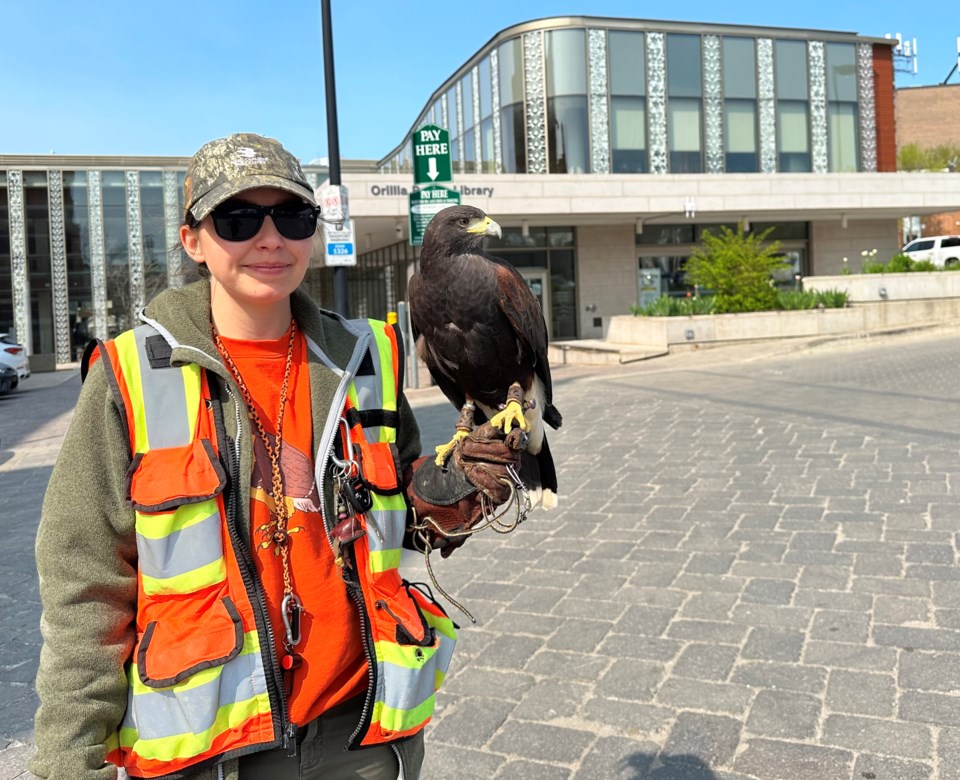Hundreds of seagulls have flocked into downtown and made Orillia their home in recent years. They can be seen nesting atop buildings and heard causing issues for downtown businesses and residents alike.
The Downtown Orillia Management Board (DOMB) has found a unique solution to the issue: a Harris Hawk named Aria.
Earlier this spring, the downtown board hired Amy MacAlpine, a commercial falconer with Royal Canadian Falconry, to bring Aria downtown over the course of several weeks to scare the birds off, while also collecting any seagull eggs found atop buildings.
So far, the effort has been successful, MacAlpine says, with seagull numbers reduced from over 300 to around 150 in the area.
With lakes Couchiching and Simcoe nearby, the downtown is an attractive location for the birds, said McAlpine, who noted many of the downtown’s rooftops, such as the gravel top of the Orillia Public Library, mimic natural nesting locations, drawing hundreds of seagulls to the area.
From feces on buildings and vehicles, to nestling seagulls falling from buildings, the birds have become an issue, DOMB officials say. However, as a protected species, there are limited options to remove the birds from the area.
“Last year was my first year dealing with it and there were quite a few seagulls,” said DOMB manager, Dina Tzirakos. “Overall, it was mostly concentrated on the block ... between West and Peter Street.”
That’s why, earlier this spring, the DOMB hired MacAlpine and her predatory birds to scare the seagulls off.
“Legally, you can't touch the eggs, you obviously can't harm a seagull … so we just reached out to the professionals so we could actually put forward a plan that would be more of a long-term solution.”
Commercial falconers have been hired in years past, Tzirakos said, but were absent through the intervening years of the pandemic.
However, with numbers on the rise, MacAlpine has been hired on an ongoing basis to work through the spring and summer, as well as into the future.
“We've already collected 50 eggs,” Tzirakos said last week. “Our falconer has already done that, and she logged that and reported that back to the Ministry. Because of being proactive, we've been able to help decrease the impact of any potential negativity throughout the tourist season.”
The process works by regularly bringing a predatory bird — a raptor — to the seagulls’ nesting area to make its presence known, MacAlpine said.
“Essentially, what we do is we come and we make a presence with our predators. In the spring, the seagulls make their migratory return to their nesting ground — they return where they were born — (and) they come and they find a raptor there," said McAlpine.
“They recognize the raptor is a threat, and they don't want to risk their lives and the lives of their offspring, and … that is enough to deter a large number of them.”
Although the Harris Hawk is a desert predator that usually hunts small mammals, McAlpine said the bird was chosen for its comfort in busy areas, like Orillia’s downtown.
“Their social nature makes them fairly easy going for busy environments, but also the target species that we're going after here, that we're trying to abate … we need a fairly large bird that is going to see our bird as an actual threat,” MacAlpine explained.
If not taken care of, seagull populations can spiral out of control, she said, referencing previous jobs.
“You can have a colony that grows exponentially, especially considering they'll have from two to four (babies) on average, but in some cases, they can have up to six babies,” she said. “So you have a colony multiplying year after year, (and) I've had some jobs where we have tens of thousands of birds.”
Aside from their offspring falling from buildings, MacAlpine said the rise of the Avian Flu, which is passed through feces, and seagulls protecting their rooftop nests, are also causes for concern.
“We're seeing an outbreak of avian influenza in the province currently, which is actually a very big deal — a lot of people are not realizing what a massive deal it is for wildlife and natural ecology,” she said. “Over the next five years, we're going to see some really bad things happening with that.”
MacAlpine also recalled a job where someone had died while carrying out maintenance on a roof.
“When people go to service (rooftop equipment), as they do annually or twice annually, gulls can swoop at them. I actually got called into a job in Toronto … there was actually a fatality because somebody fell off the rooftop,” she said.
Although her work in Orillia’s downtown has been successful so far, MacAlpine said she will need to return on a regular basis to deter the seagulls over the long term.
“We're already in line for next year to start right on time, and the year after, because we anticipate it's going to take probably at least two seasons,” she said.
The Harris Hawk, Aria, declined to comment for this story.
